Killarney National Park: Difference between revisions
Created page with "right|thumb|390px|The Ladies' View, Killarney {{county|Kerry}} '''Killarney National Park''' ({{lang|ga|Páirc Náisiúnta Chill Airne}}), near the to..." |
|||
| Line 105: | Line 105: | ||
[[Category:National Parks of the Republic of Ireland|Killarney]] | [[Category:National Parks of the Republic of Ireland|Killarney]] | ||
[[Category:Forests and woodlands of | [[Category:Forests and woodlands of County Kerry]] | ||
Latest revision as of 15:05, 3 June 2022
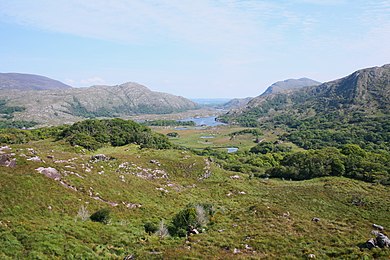
Killarney National Park (Irish: Páirc Náisiúnta Chill Airne), near the town of Killarney in County Kerry, is a national park: it was the first national park established in the Republic of Ireland, created when the Muckross Estate was donated to the Irish Free State in 1932.[1] The park has since been substantially expanded and encompasses over 25,425 acres of diverse ecology, including the Lakes of Killarney, oak and yew woodlands of international importance,[2] and mountain peaks. It has the only red deer herd on mainland Ireland and the most extensive covering of native forest remaining in Ireland. The park is of high ecological value because of the quality, diversity, and extensiveness of many of its habitats and the wide variety of species that they accommodate, some of which are rare. The park was designated a UNESCO Biosphere Reserve in 1981.
The park forms part of a Special Area of Conservation and a Special Protection Area.
Climate and geography
- Location map: 51°59’36"N, 9°33’26"W
Killarney National Park is in County Kerry and close to Ireland's most westerly point.[1] The Lakes of Killarney and the Mangerton, Torc, Shehy and Purple Mountains are within the park. Altitudes in the park range from 72 feet to 2,762 feet.
A major geological boundary between Devonian Old Red Sandstone and Carboniferous limestone lies in the park. The underlying geology of the majority of the park is sandstone, with the limestone pavements occurring on the low eastern shore of Lough Leane.
Lough Leane is the largest of the Killarney lakes and contains over 30 islands. Some visitors avail of boat trips to Innisfallen, one of the larger islands on Lough Leane.
The geological boundary, the park's wide range of altitudes, and the climatic influence of the Gulf Stream combine to give the park a varied ecology.[1] These ecosystems include bogs, lakes, moorland, mountains, waterways, woodland, parks and gardens. Outcropping rock, cliffs and crags are features of the park. Above 650 feet, the mountainous sandstone areas support large areas of blanket bog and heath.
Lakes of Killarney
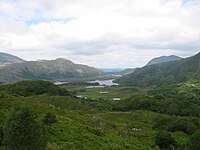
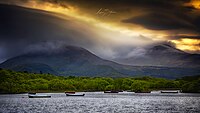
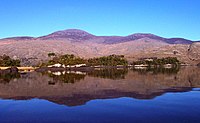
- Main article: Lakes of Killarney
The Lakes of Killarney are Lough Leane (the lower lake), Muckross Lake (the middle lake), and the Upper Lake. These lakes are interlinked and together make up almost a quarter of the park's area. Despite being interlinked, each lake has a unique ecosystem. The lakes join at the Meeting of the Waters, a popular tourist area. Sport angling on the lakes has been a pastime in the area for some time, in particular of the lakes' brown trout and salmon populations.
Lough Leane is by far the largest of the three lakes. It is also the largest body of fresh water in the region. It is also the lake richest in nutrients. It has become eutrophic as a result of phosphates from agricultural and domestic pollution entering Lough Leane Reedbed, an important habitat on the edge of Lough Leane. This nutrient enrichment has caused several algal blooms in recent years. The blooms have not yet had a severe effect on the lake's ecosystem. To prevent further pollution causing a permanent change in the lake's ecosystem, a review of land use in the [catchment area is being carried out. Water quality in the lake appears to have improved since phosphates were removed from sewage in 1985. As of August 2007, several large hotels and businesses have stated their intention to stop using phosphate detergents, in an effort to preserve the quality of the lake water.
Muckross Lake is the deepest of the three lakes: it has a maximum depth of 241 feet, close to where the steeply sloping side of Torc Mountain enters the lake. The lake lies on the geological boundary between the sandstone mountains to the south and west and the limestone to the north.
Lough Leane and Muckross Lake lie across the geological boundary. The presence of limestone causes both of the lakes to be slightly richer in nutrients than the Upper Lake. There are many caves in the limestone at lake level, created by wave action combined with the dissolution effect of the lakes' acidic water on the exposed rock. These caves are largest on the northern shore of Muckross Lake.
From the Meeting of the Waters a narrow channel called the Long Range leads to the Upper Lake, the smallest of the three lakes. This lake is located in rugged mountain scenery in the upper Killarney/Black Valley area. The fast run-off in its catchment area can cause the level of the lake to rise by up to a meter in a few hours during heavy rain.
Muckross Lake and the Upper Lake are high quality oligotrophic systems, with water that is slightly acidic and low in nutrients. This is caused by run-off from the upland sandstones and blanket bogs in their catchment areas. They have diverse Aquatic plant|aquatic vegetation, including quillwort (Isoetes lacustris), shoreweed (Littorella uniflora), and water lobelia (Lobelia dortmanna).
All three lakes are very acid sensitive and therefore vulnerable to afforestation within their catchment areas.
Woodlands
Killarney possesses the most extensive area (approximately 46 square miles) of semi-natural native woodland (woodland dominated by indigenous species) remaining in Ireland. Most of this woodland is encompassed by the national park. There are three main types of woodland in the park: acidophilous oak woodland (Quercus petraea-Ilex aquifolium) on Devonian sandstone; moss-rich yew woodland (Taxus baccata) on Carboniferous limestone outcrops; and wet woodland (also called carr) dominated by alder on low-lying swampy limestone soils on the lake edges. The woods in the park fall naturally into two sectors, along the geologic divide. The oak and yew woodlands are of international importance.[2]
Mixed woodland and conifer plantations also occur in the park. The mixed woodland on Ross Island has one of the richest herb layers in the park's woods.
Grazing and rhododendron invasion threaten the park's woodlands. Rhododendrons affect approximately two-thirds of the oak woodlands. A rhododendron removal programme is under way in the park. The yew woodlands have been negatively affected by heavy grazing for many years.
Oak woodlands
The park is perhaps most famous for its oak woodlands, which are about four and a half square miles in size. They form the largest area of native woodland remaining in Ireland and are a remnant of the woodland that once covered much of Ireland. Derrycunihy Wood is perhaps the most natural sessile oak (Quercus petraea) wood in Ireland. Most of the oak woodlands are located on the lower slopes of the Shehy and Tomy mountains, adjacent to Lough Leane. They are typically dominated by sessile oak, which favours the acidic soils of the sandstone mountains.
The oak woodlands typically have an understory of holly (Ilex aquifolium). Strawberry trees (Arbutus unedo) are a notable part of these woods. There are also scattered Taxus baccata|yews. The field layer includes bilberry and woodrush. The herb layer is not rich in species.
Bryophytes, lichens and filmy ferns (Hymenophyllaceae), thrive in the humid oceanic climate. Species with restricted Atlantic distributions grow in the woods.[2] The bryophytes in these woods are perhaps the best-developed Atlantic bryophyte community in Europe. The remote Glaism na Marbh valley has a particularly rich flora of bryophytes, some of which are scarce or absent in other parts of the woods. Mosses, ferns and liverworts frequently occur as epiphytes, attached to the trunks and branches of oak trees. Rare species growing in the woods include Cyclodictyon laetevirens, Daltonia splachnoides, Lejeunea flava, Radula carringtonii, and Sematophyllum demissum.
Bird species that reside in the oak woods include blue tit, common chaffinch, goldcrest, robin, and wren. Mammals include badger, fox, pine marten, red deer, sika deer, and red squirrel. Insects include many species of the parasitic gall wasp and the purple hairstreak butterfly, whose caterpillar is entirely dependent upon oak trees.
The introduced common rhododendron is a large threat to certain areas of the oak woods. For example, it is widespread throughout Camillan Wood despite ongoing attempts to control it.[2]
Yew woodlands
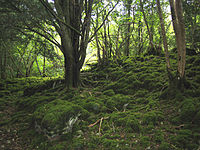
The yew woodland in the park is known as Reenadinna Wood. It is about 62 acres in size and is located on low-lying karst limestone pavement between Muckross Lake and Lough Leane on Muckross Peninsula.[2] Yew woodland is the rarest habitat type in the park.[3] It is the only significant area of yew woodland in Ireland. Muckross bog, a raised bog of five acres, is in the southern part of the wood. There are hollows between the limestone outcrops. Deep rendzina soils have developed in some of the hollows. It is estimated that the wood developed 3,000–5,000 years ago.
Some of the trees in Re-enadinna wood are two hundred years old. There has been little regeneration of the yew trees in the wood. Overgrazing of the woodland floor by sika deer may be part of the reason for this, but small areas of the wood that have been fenced off since 1969 have experienced very little yew regeneration. The dense canopy created by the yew trees that lets very little sunlight through to the woodland floor may also prevent the growth of yew seedlings.[3]
Despite its poisonous properties, yew is very susceptible to browsing and bark stripping by deer, rabbits, hare, and domestic animals. It is one of the most grazing sensitive trees in the Killarney woodlands. sika deer have killed yews by scoring the trees with their antlers.
Wet woodlands
Wet woodland (also called carr) on the low-lying swampy limestone areas within Lough Leane's floodplain is about 420.1 acres (1.7 km²) in size.[4] This is one of the most extensive areas of this woodland type in Ireland. The dominant canopy species here are alder (Alnus glutinosa), ash (Fraxinus excelsior), downy birch (Betula pubescens), and willow (Salix spp.). The areas that are periodically covered by water are rich in species including grasses, rushes, sedges, and flowers such as marsh bedstraw, meadow sweet, and water mint.
Red deer and sika deer heavily use the wetland woods as cover, and bare muddy "deer wallows" are a characteristic feature. Rhododendrons are the greatest threat to these woodlands. They are invading the woodlands, using raised areas such as tussocks or tree bases where the floor is too wet for seedlings to become established. Although some clearance has occurred reinvasion continues.[4]
Bogland
While the lower slopes of the mountains are dominated by sessile oak (Quercus petraea), above 650 feet the mountains are virtually treeless and are dominated by blanket bog and wet heath. The bogs in the park mostly have a characteristic flora that includes heather (Calluna vulgaris), bell heather (Erica cinerea) and western gorse (Ulex gallii), with occasional bilberry (Vaccinium myrtillus). Large-flowered butterwort (Pinguicula grandiflora) is common. The bogs also support a number of notable species, including mosses (Sphagnum pulchrum, S. fuscum, S. platyphyllum, S. strictum, S. contortum and Calliergon stramineum), liverworts (Cladopodiella francisci and Calypogeia azurea) and lichens (Cladonia mediterranea, C. macilenta, C. rangiferina, C. arbuscula and Cetraria islandica).
The remoteness of some of the upland areas aids the survival of Ireland's only remaining wild herd of native red deer.[1] The bogs are threatened by grazing, turbary, burning and afforestation.
Tourism
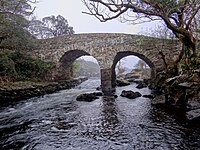
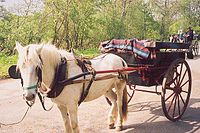
- Main article: Muckross House
The park is open for tourism year-round. There is a visitor and education centre at Killarney House. Visitor attractions in the park include Dinis Cottage, Knockreer Demesne, Inisfallen Island, Ladies View, the Meeting of the Waters and the Old Weir Bridge, Muckross Abbey, Muckross House, the Muckross Peninsula, the Old Kenmare Road, O'Sullivan's Cascade, Ross Castle and Ross Island, Tomies Oakwood, and Torc Waterfall. There is a network of surfaced paths in the Knockreer, Muckross, and Ross Island areas that can be used by cyclists and walkers. The Old Kenmare Road and the track around Tomies Oakwood have views over Lough Leane and Killarney. Boat trips on the lakes are available.
Muckross House is a Victorian mansion, close to Muckross Lake's eastern shore, beneath the backdrop of Mangerton and Torc mountains. The house has now been restored and attracts more than 250,000 visitors a year. Muckross Gardens are famous for their collection of rhododendrons, hybrids and azaleas, and exotic trees. Muckross Traditional Farms is a working farm project that recreates Irish rural life in the 1930s, prior to electrification. Knockreer House is used as the National Park Education Centre.
Outside links
References
- ↑ 1.0 1.1 1.2 1.3 About Killarney National Park: Dúchas
- ↑ 2.0 2.1 2.2 2.3 2.4 Perrin, Philip M.; Kelly, Daniel L.; Mitchell, Fraser J.G.: Long-term deer exclusion in yew-wood and oakwood habitats in southwest Ireland: Natural regeneration and stand dynamics: Forest Ecology and Management
- ↑ 3.0 3.1 Dúchas. "Reenadinna". http://homepage.eircom.net/~knp/yew/index.htm.
- ↑ 4.0 4.1 Kelly, Daniel L.; Susan F. Iremonger (1997). Irish Wetland Woods: The Plant Communities And Their Ecology. Royal Irish Academy. http://www.ria.ie/publications/journals/procbi/1997/PB97I1/PDF/97101BI.pdf.
| National Parks of the Republic of Ireland |
|---|
|
The Burren • Connemara • Glenveagh • Killarney • Wicklow Mountains Wild Nephin • |